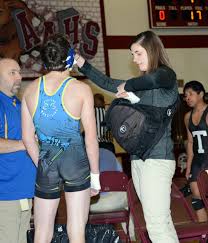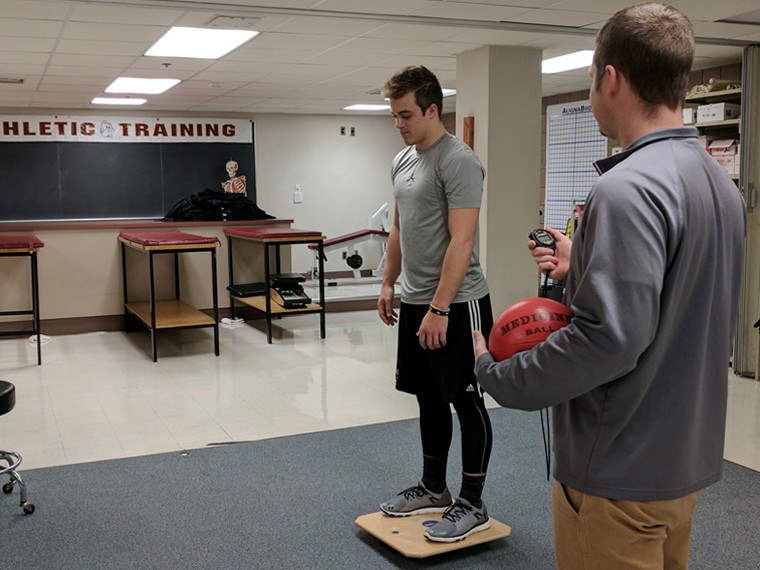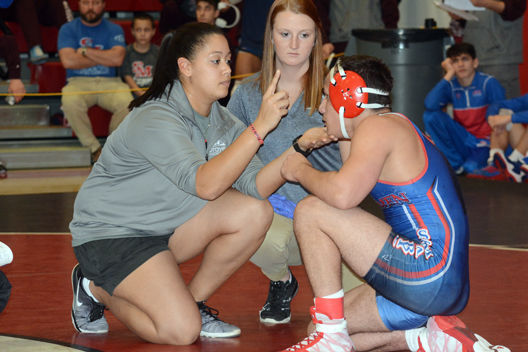
Article reposted from The Progress
Author:
West Branch’s Ashlee McQuown has been around sports all her life. Her mom was a successful basketball coach at Glendale, and she and her two sisters all played sports in high school.
McQuown, who played basketball, volleyball and softball in school, had thoughts of continuing her basketball career at the University of Pittsburgh at Bradford, but injuries and a desire to to give her all to her major scuppered the idea.
“I grew up in an athletic family,” McQuown said. “From the time I was young, sports were a major part of my life. So I knew when I graduated I didn’t want to leave that aspect of my life behind. I also love to help people. I have been blessed with people always being gracious and helping me when I asked, so I wanted to be able to pay it forward. It wasn’t until my senior year of high school that I put the two together and decided to become an athletic trainer.
“I did not have a major injury until my senior year in high school. The care, appreciation and work to get me to return to play as soon as possible by my certified athletic trainers created a lasting effect on me, and I knew that this was the job for me.”
McQuown has put her all into her profession, working long hours and putting in a lot of legwork on the West Branch campus.
The Glendale High School graduate started working for the school right after her graduation from Pitt-Bradford, and she hasn’t looked back since.
That was seven years ago.
Since coming to the school, lots of things have changed. Coaches have come and gone, but the student-athletes of the school and the administration have come to rely on McQuown and her expertise.
That expertise has only grown since she started, as the Glasgow native completed her Master’s degree in exercise science and health promotion with a concentration in sport psychology from California University of Pennsylvania.
All of the knowledge helps her when dealing with her student-athletes on a daily basis. And, since McQuown is contracted through the school and not through a company like Drayer, she has the luxury of devoting all of her time to her kids.
Since every sport season is different, McQuown broke down one of her recent days in the winter.
“My start time does not begin until 12:30-1 p.m.,” she said. “When I arrive, I take care of paperwork and athletic files or treatment programs until any athletes are available for treatment or rehabilitation during study hall periods. On this particular day, girls basketball teams are away, boys basketball teams are practicing and wrestling teams have a home event.
“Since I cover junior high and varsity events, when my junior high girls basketball team is dismissed for traveling to their game, I tape and treat any of the girls who need it before they leave. Once school is dismissed, the boys basketball players will come down to the athletic training room for taping and treatment if needed. They will practice for two hours after school, which is the exact amount of time before wrestling begins to set up for their home meet.
“During the set up time, I am taping and treating any varsity girls basketball players who need it before they depart for their game. I then take all of my necessary equipment and supplies into the gym for the wrestling meet. The teams weigh in at 5 p.m., and once they are changed and cleared to participate, they come to me for taping and treatment. Junior high wrestling begins at 6 p.m., where I take care of any injuries, blood time and first aid that is required. Varsity wrestling begins directly after junior high, usually at 7 p.m.
“During this time, I take care of the same things as junior high required, as well as tape and monitor the cheerleading squads during their stunts in between bouts. Once the match has ended, I make sure all the athletes that require ice or post-event treatment are taken care of and accounted for, and then I begin to clean up all supplies that were utilized during the event. Usually, on a good night, I am able to leave the school to travel home by 9 p.m.”
Despite the long days and hours that she puts in, McQuown says she loves her job. One of the biggest reasons — her kids.
“The athletes, hands down are why I love my job,” she said. “Although there are times that they can really push your buttons by not listening or trying to get out of treatments, my athletes are the reason why I can be excited to go to work every day. It makes it so much easier to know that they trust me and will do what I say (sometimes with resistance or attitude) because they know that the only thing I want for them is to be the best and most successful athlete that they can be.
“It is honestly the best thing in the world to watch these athletes succeed, and I will always want to be there for them in any way that I can. Their successes makes every hard day in this profession worth it.”
McQuown also enjoys the relationships she has built with the school’s coaching staffs and administration.
“The coaching staffs at West Branch are also another factor into why I can be happy to pull into work,” McQuown said. “There are always horror stories about coaches that will go behind athletic trainers backs and not listen to a word that they say when athletes are injured, but this is not the case here. My coaches respect me, and carry the same goals that I have for these athletes: to be the best that they possibly can be. Many of the coaches here have become not just coworkers, but friends.
“Finally, the administration and community of West Branch School District has to be one of the most supportive and respectful areas in the state when it comes to my profession. They have always gone to bat for me. The amount of support and thanks that I receive from those around and involved with this district is overwhelming. It isn’t hard to walk into a building and love your job when you have all of these things stated above to come in to. I am certainly blessed.”
While most fans and parents at the school only see McQuown during game times or practices, the extra work that she puts in behind the scenes sometimes goes unnoticed.
That includes her time speaking with physicians, physical therapists and her work at outside events like the District 6 Wrestling Championships and Southwest AA Regional wrestling.
“I think the one thing that people don’t realize about certified athletic trainers is the amount of time we spend behind the scenes, and the amount of work that is actually put into the career,” she said. “I have had many people make the comment that athletic trainers just go and sit at events when they begin, that we are just there for show time. This is hardly the case.



